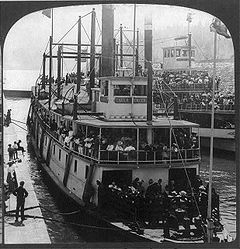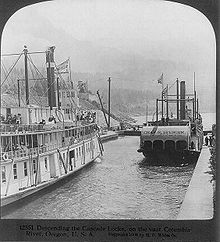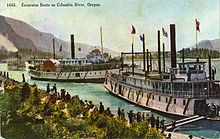- Charles R. Spencer
-
Charles R. SpencerCareer Name: Charles R. Spencer Port of registry: US # 127574 Route: Columbia River Builder: Capt. E.W. Spencer In service: 1901 Notes: Renamed Monarch in 1911. General characteristics Type: inland steamboat, shallow-draft express passenger Tonnage: 598 gross tons; 474[1] or 409[2] net tons Length: 184 ft (56 m)[1] Beam: 21 ft (6 m)[2] Depth: 6.0 ft (2 m) depth of hold.[2] Installed power: twin steam engines, horizontally mounted, 20" bore by 96" stroke, 26.6 nhp Propulsion: sternwheel Speed: About 19 miles per hour (maximum)[3] Notes: Later known as Monarch Charles R. Spencer (generally called the Spencer) was a steamboat built in 1901 to run on the Willamette and Columbia rivers from Portland, to The Dalles, Oregon. This vessel was described as an "elegant passenger boat".[1] After 1911 this vessel was rebuilt and renamed Monarch.
Contents
Characteristics
Charles R. Spencer and Bailey Gatzert descending Cascade Locks circa 1906.
The Spencer was considered one of the elite vessels of its time. It had a bright red smokestack and a steam whistle so loud that it was said to have "made rotten piles totter."[1]
Operations
 Bailey Gatzert (on left) and Charles R. Spencer (on right), eastbound on the Columbia River, approaching Cascades Locks.
Bailey Gatzert (on left) and Charles R. Spencer (on right), eastbound on the Columbia River, approaching Cascades Locks.
E.W. Spencer operated Spencer as an independent enterprise. Although steamboat racing was technically illegal, operators of steamboats often tried to "do their best" when a rival steamboat was on the river. Spencer as a prestige boat was frequently raced against other top vessels of the day, including Bailey Gatzert and T.J. Potter.[1] Races against the Bailey Gatzert happened almost every day when the two vessels ran against each other on the Portland-The Dalles route.[4] It has been reported that at one time in 1906, when Spencer was running behind Bailey Gatzert, the captain of Spencer made up the time by running the Cascades Rapids (an extremely risky undertaking) while Bailey Gatzert was moving through the Cascade Locks .[5]
On July 12, 1904, Spencer was racing the Oregon Railway and Navigation Company's Hood River.[6] The winds were high, and blowing east against the steamers as they moved downstream, and the waves were choppy. The Spencer 's main steam pipe broke, which forced the pilot to steer for the river bank to beach the vessel. Spencer hit rocks 25 feet from shore, and sank. Fortunately there were no casualties among those aboard. Spencer was later refloated and repaired.[1] In 1905, Captain Spencer continued to be in sharp competition for the passenger traffic on the routes from Portland to Astoria and to The Dalles. His competitors included the Oregon Railway and Navigation Company, and also Captain U.B. Scott, owner of edit] Collision with Dalles City
This photograph is from an old colorized postcard. The view is towards the west, and shows T.J. Potter pulling away from a landing, probably just before entering the Cascade Locks. Another steamer, a sternwheeler, is in the foreground, this is possibly the Charles Spencer. Coming up to the landing from the west another steamer can be seen, which from the vessel's apparent configuration and the white collar on her funnel, appears to be the Bailey Gatzert. The large crowds on all the steamers are readily visible; this is an excellent depiction of the high point of steamboat operations on the river.
On May 31, 1905, a collision during one of these races between Dalles City and the Spencer generated substantial litigation.[3] Dalles City was struck by the Charles R. Spencer while the Spencer was trying to overtake Dalles City. As a result, Dalles City suffered serious and disabling mechanical damage.[3] The opinion of the court describes the fierce commercial competition which was the occasion for the race on that date:
The boats were plying between Portland and The Dalles, and belonged to opposition lines which were aggressively competing for the passenger business of the two terminal cities and intermediate points along the Willamette and Columbia rivers. The first to arrive at any place along the route where passengers were received secured the larger part of the business, and, both boats being scheduled to leave Portland at the same hour, speed became an important consideration. The Charles R. Spencer was the larger, more powerful, and swifter craft, and, with equal opportunity, could outstrip her rival. Upon the morning in question, they left the Portland clocks at about 7 o'clock, the Dalles City passing out through the drawbridges a few hundred feet ahead of the Charles R. Spencer. A struggle at once began, the Charles R. Spencer seeking by her superior speed to pass her competitor, and the Dalles City to maintain the advantage that she had secured in making the start. The Dalles City was apparently under a full head of Steam, and moved at the rate of 17 or 18 miles an hour. The Charles R. Spencer, necessarily following practically the same course, pushed close up in her wake, and two or three times essayed to pass, but without avail. Here arises the first substantial conflict in the testimony. Upon behalf of the Charles R. Spencer it is charged that her failures to pass were due to the "jockeying" maneuvers of the Dalles City in swinging across her course from time to time, and thus crowding her out.[3]
In November 1905, the Spencer, Dalles City, and Telephone all cast off lines at once in Portland, and headed downriver for Astoria. As each vessel raced down the Willamette at high speed, they threw up a wake which rocked and damaged large ships moored alongside piers, which resulted in the captains of the steamboats each being fined $50, a considerable sum for the time.[1][7]
Freight work
In September 1906, Spencer began transporting wheat from inland Oregon and Washington in cooperation with the Open River Navigation Company. The boats of the Open River company would pick up the wheat on points on the river above Celilo, bring the wheat down to Celilo, where it would be loaded on the portage railway that ran along the river to a point above the Dalles, where the wheat would be loaded onto the Spencer to be brought down to tidewater at Portland, transiting the Cascade Locks en route.[1][7] Another source states that Spencer was taken over by the Open River company.[2]
Later career
The rising automobile business took away Spencer's main routes, and in 1911 the vessel was rebuilt and renamed Monarch.[7]
Spencer was transferred to California in 1914.[2] One of Spencer's early captains was Edgar E. Bateman (1856-1949).[1]
Notes
- ^ a b c d e f g h i Newell, Gordon R., H.W. McCurdy Marine History of the Pacific Northwest, at 69, 88, 103, 111, 123, 191, 567, Superior Publishing, Seattle WA 1966 ISBN 0875642209
- ^ a b c d e Affleck, Edward L., A Century of Paddlewheelers, at pages 9-10.
- ^ a b c d The Charles R. Spencer" 178 Fed. 862 (9th Cir. 1911).
- ^ Newell and Williamson, Pacific Steamboats, at page 64.
- ^ "Monarch (ex-"Charles R. Spencer"), Oregon State Library photograph collection, image 2003.001.0105
- ^ Marshall, Oregon Shipwrecks, at page 204.
- ^ a b c Timmen,Blow for the Landing, at pages 30, 40, 100, and 118.
References
- Affleck, Edward L., A Century of Paddlewheelers in the Pacific Northwest, the Yukon, and Alaska, Alexander Nicolls Press, Vancouver, BC 2000
- Marshall, Don, Oregon Shipwrecks, Binford and Mort, Portland 1984 ISBN 0-8323-0430-1
- Newell, Gordon R., H.W. McCurdy Marine History of the Pacific Northwest, Superior Publishing, Seattle WA 1966 ISBN 0875642209
- Newell, Gordon R., and Williamson, Joe, Pacific Steamboats, Bonanza Books, New York, NY 1958
- Timmen, Fritz, Blow for the Landing -- A Hundred Years of Navigation on the Waters of the West, Caxton, Caldwell, Idaho, 1973 ISBN 0-87004-221-1
Further reading
- Faber, Jim, Steamer's Wake, Enetai Press, Seattle, WA 1985 ISBN 0-9615811-0-7
- Mills, Randall V., Stern-wheelers up Columbia -- A Century of Steamboating in the Oregon Country, University of Nebraska Press, Lincoln, NE (1947)
Steamboats of Oregon and the Columbia River basin Coastal vessels - General Miles
- Life-Line
- T.M. Richardson
- Washington
Vessel lists Modern ferries - Wahkiakum County Ferry
- Needles-Fauquier Ferry (Arrow Lakes)
Steamboat lines Steamboat owners and captains - John C. Ainsworth
- John Bonser
- John H. Couch
- Joseph Kellogg
- James W. Troup
- Henry Villard
Builders and shipyards Shipwrecks British Columbia- Upper Fraser River
- Lakes Route
- Arrow Lakes
- Okanagan Lake
- Upper Columbia and Kootenay Rivers
- Skeena River
- Stikine River
- Peace River
Alaska and YukonOtherNavboxes - Puget Sound
- British Columbia
- Oregon Coast
- California
Lists of vessels - Ships in British Columbia
- Retired BC ferries
- Royal Navy ships in the Pacific Northwest
- Steamboats on the Columbia River
- Puget Sound steamboats
related topic : Puget Sound Mosquito FleetSteamboats of California Particular vessels Water routes - Sacramento River
- San Joaquin River
- Colorado River
- California Coast
- San Francisco Bay & Delta
Steamboats in other areas Categories:- Steamboats of Oregon
- Steamboats of California
- Paddle steamers
- Columbia River
- Steamboats of the Columbia River
- Ships built in Washington (state)
- 1901 ships
- Passenger ships of the United States
Wikimedia Foundation. 2010.



